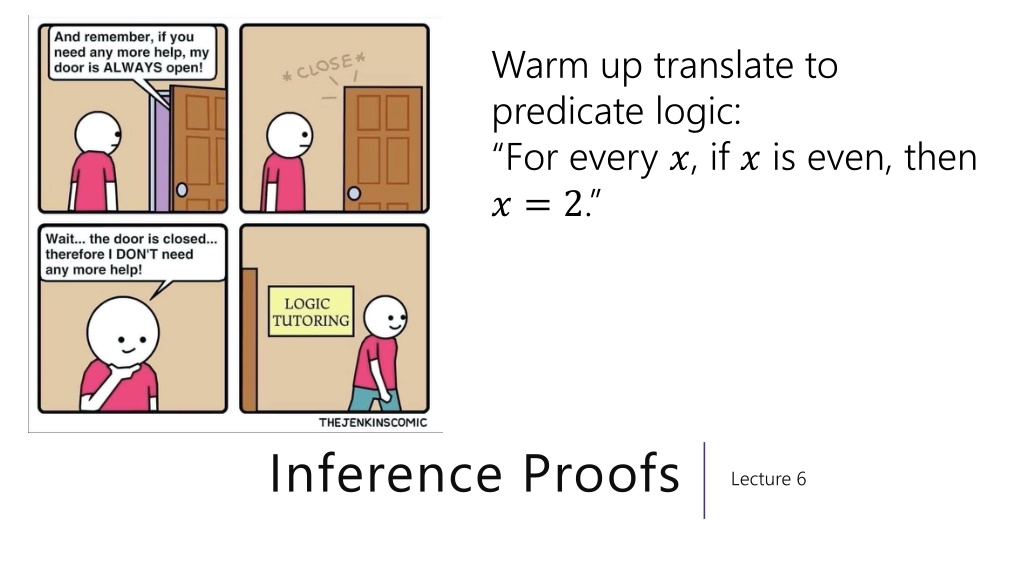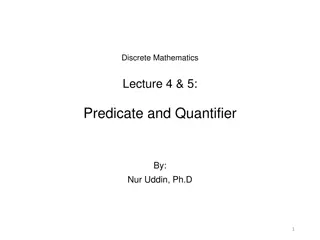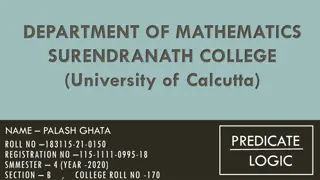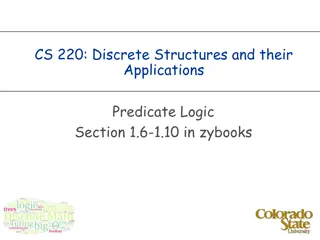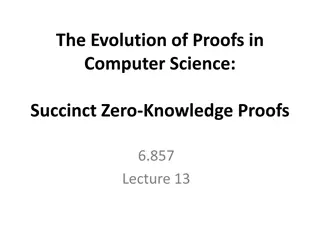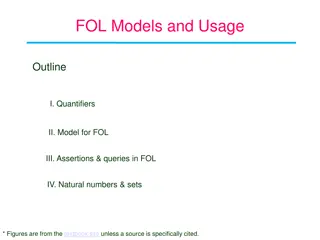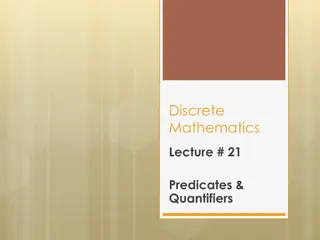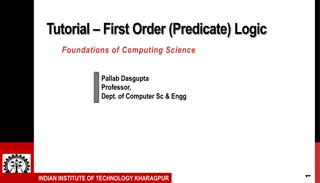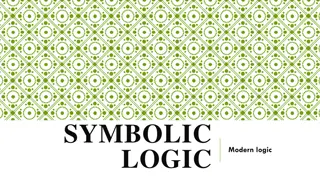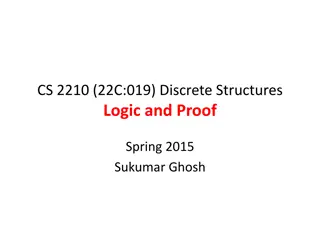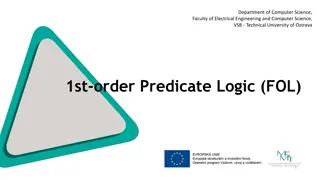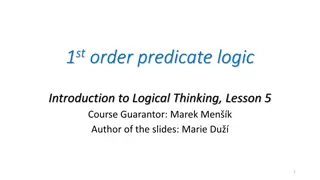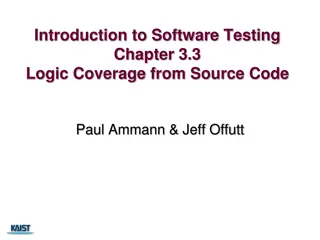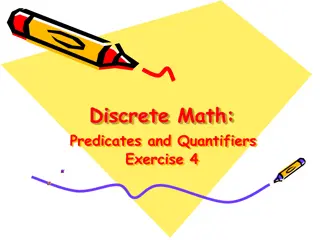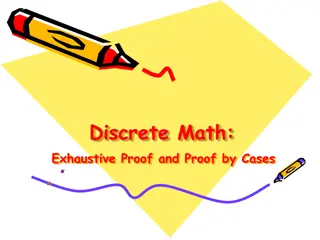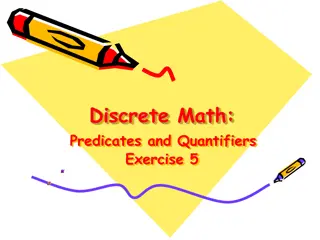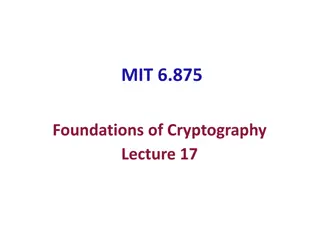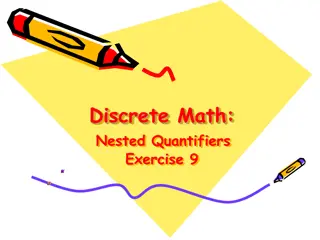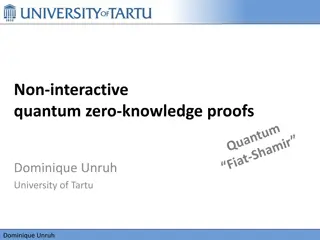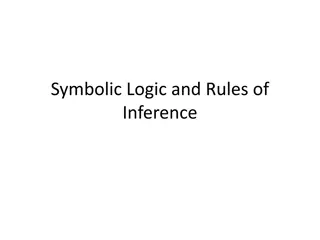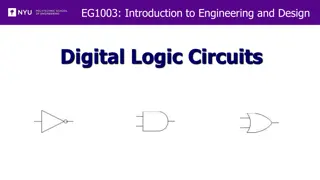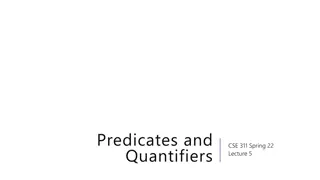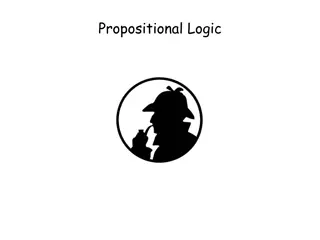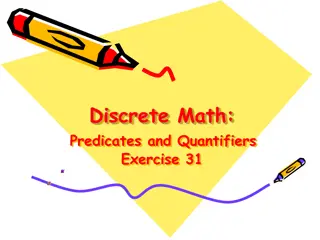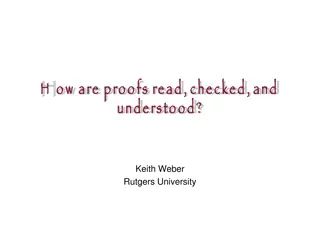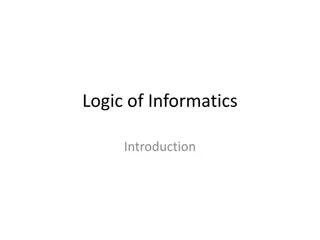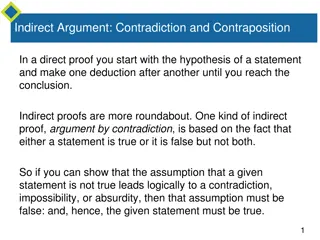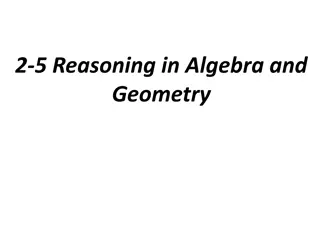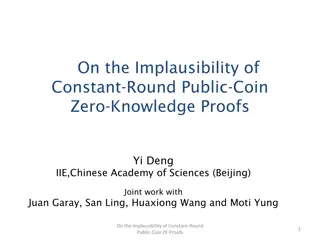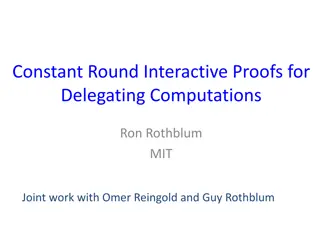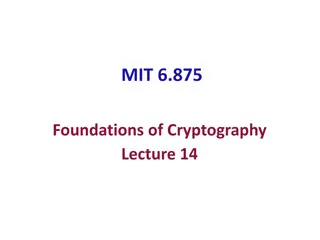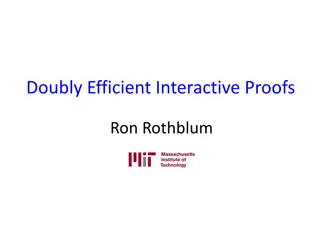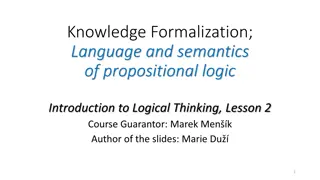Understanding Predicate Logic and Quantifiers for Symbolic Proofs
Dive into the realm of predicate logic and quantifiers, exploring the nuances of symbolic proofs and evaluating logical statements. Learn about bound variables, domain considerations, and strategies for constructing iron-clad proofs using quantifiers.
Download Presentation

Please find below an Image/Link to download the presentation.
The content on the website is provided AS IS for your information and personal use only. It may not be sold, licensed, or shared on other websites without obtaining consent from the author. Download presentation by click this link. If you encounter any issues during the download, it is possible that the publisher has removed the file from their server.
E N D
Presentation Transcript
Warm up translate to predicate logic: For every ?, if ? is even, then ? = 2. Inference Proofs Lecture 6
Evaluating Predicate Logic For every ?, if ? is even, then ? = 2. / ?(Even ? Equal ?,2 ) Is this true?
Evaluating Predicate Logic For every ?, if ? is even, then ? = 2. / ?(Even ? Equal ?,2 ) Is this true? TRICK QUESTION! It depends on the domain. Prime Numbers Positive Integers Odd integers True False True (vacuously)
One Technical Matter How do we parse sentences with quantifiers? What s the order of operations? We will usually put parentheses right after the quantifier and variable to make it clear what s included. If we don t, it s the full expression. Parentheses often end up not mattering in real expressions. Be careful with repeated variables they don t always mean what you think they mean. ?(? ? ) are different ? s. ? ? ?
Bound Variables What happens if we repeat a variable? Whenever you introduce a new quantifier with an already existing variable, it takes over that name until its expression ends. ?(? ? ? ? ? ? ? ) It s common (albeit somewhat confusing) practice to reuse a variables when it wouldn t matter . Never do something like the above: where a single name switches from gold to purple back to gold. Switching from gold to purple only is usually fine but names are cheap.
More Practice Let your domain of discourse be fruits. There is a fruit that is tasty and ripe. ?(Tasty ? Ripe ? ) For every fruit, if it is not ripe then it is not tasty. ?( Ripe ? Tasty ? ) There is a fruit that is sliced and diced. ?(Sliced ? Diced ? )
This Week This week we have two big topics: Using and understanding quantifiers Writing symbolic proofs (that aren t just simplifying) Both of them are better if learned spaced out with practice, so Every lecture this week is split in half, with a little bit on each topic. Today: Tools for more complicated proofs. Negating Quantifiers
Today A new way of thinking of proofs: Here s one way to get an iron-clad guarantee: 1. Write down all the facts we know. 2. Combine the things we know to derive new facts. 3. Continue until what we want to show is a fact.
Drawing Conclusions You know If it is raining, then I have my umbrella And It is raining You should conclude . I have my umbrella! For whatever you conclude, convert the statement to propositional logic will your statement hold for any propositions, or is it specific to raining and umbrellas? I know (? ?) and ?, I can conclude ? Or said another way: ? ? ? ?
Modus Ponens The inference from the last slide is always valid. I.e. ? ? ? ? T
Modus Ponens a formal proof ? ? ? ? [ ? ? ?] ? ? ? ? F ? ? ? ? ? ? ? ? [ ? ?] ? [? ?] ? T T Law of Implication Commutativity Distributivity Negation Commutativity Identity Law of Implication DeMorgan s Law Associativity Commutativity Negation Domination ? ? ? ? ? ? ? ? ? F ? ? ? ? ?
Modus Ponens The inference from the last slide is always valid. I.e. ? ? ? ? T We use that inference A LOT So often people gave it a name ( Modus Ponens ) So often we don t have time to repeat that 12 line proof EVERY TIME. Let s make this another law we can apply in a single step. Just like refactoring a method in code.
Notation Laws of Inference We re using the symbol A LOT. Too much Some new notation to make our lives easier. If we know both both ? and ? ?,? We can conclude any (or all) of ?,? ?,? means therefore I knew ?,? therefore I can conclude ?,?. ? ?,? Modus Ponens, i.e. ? ? ? ?), in our new notation. ?
Another Proof Let s keep going. I know If it is raining then I have my umbrella and I do not have my umbrella I can conclude It is not raining! What s the general form? How do you think the proof will go? If you had to convince a friend of this claim in English, how would you do it? [(? ?) ?] ?
A proof! We know ? ? and ?; we want to conclude ?. Let s try to prove it. Our goal is to list facts until our goal becomes a fact. We ll number our facts, and put a justification for each new one.
A proof! We know ? ? and ?; we want to conclude ?. Let s try to prove it. Our goal is to list facts until our goal becomes a fact. We ll number our facts, and put a justification for each new one. Given Given Contrapositive of 1. Modus Ponens on 3,2. 1. ? ? 2. ? 3. ? ? 4. ?
Try it yourselves Suppose you know ? ?, ? ?,and ?. Give an argument to conclude ?. Fill out the poll everywhere for Activity Credit! Go to pollev.com/cse311 and login with your UW identity Or text cse311 to 22333
Try it yourselves Suppose you know ? ?, ? ?,and ?. Give an argument to conclude ?. Given Given Given Modus Ponens 1,3 Contrapositive of 2 Modus Ponens 5,4 1. ? ? 2. ? ? 3. ? 4. ? 5. ? ? 6. ?
More Inference Rules We need a couple more inference rules. These rules set us up to get facts in exactly the right form to apply the really useful rules. A lot like commutativity and distributivity in the propositional logic rules. I know the fact ? ? ? ? Eliminate I can conclude ? is a fact and ? is a fact separately separately. ?,?
More Inference Rules In total, we have two for and two for , one to create the connector, and one to remove it. ? ? Eliminate ?;? Intro ? ? ?,? ? ? ?, ? Intro Eliminate ? ?,? ? ? None of these rules are surprising, but they are useful.
The Direct Proof Rule We ve been implicitly using another rule today, the direct proof rule Write a proof given ? conclude ? ? ? Direct Proof rule ? ? ? ? This rule is different from the others ? ?is not a single fact. It s an observation that we ve done a proof. (i.e. that we showed fact ? starting from ?.) We will get a lot of mileage out of this rule starting next time.
Caution Be careful! Logical inference rules can only be applied to entire They cannot be applied to portions of a statement (the way our propositional rules could). Why not? Suppose we know ? ?, ?. Can we conclude ?? Given Given Introduce (1) Introduce (2) Modus Ponens 3,4. entire facts. 1. ? ? ? Intro 2. ? ? ?,? ? 3. ? ? ? 4. ? ? 5. ?
One more Proof Show if we know: ?,?, ? ? ? ? ,? ? we can conclude ?.
One more Proof Show if we know: ?,?, ? ? ? ? ,? ? we can conclude ?. Given Given Given Given Intro (1,2) Modus Ponens (3,5) Eliminate (6) Modus Ponens (4,7) 1. ? 2. ? 3. [ ? ? ? ? ] 4. ? ? 5. ? ? 6. ? ? 7. ? 8. ?
Inference Rules ? ? ? ? Eliminate Direct Proof rule ?,? ? ? ? ?, ? ? ?;? Eliminate Modus Ponens ? ? ?;? Intro You can still use all the propositional logic equivalences too! ? ? ? Intro ? ?,? ?
Quantifiers (for A All) and (there E Exists) Write these statements in predicate logic with quantifiers. Let your domain of discourse be cats This sentence implicitly makes a statement about all cats! If a cat is fat, then it is happy. ?[Fat ? Happy ? ]
Quantifiers Writing implications can be tricky when we change the domain of discourse. If a cat is fat, then it is happy. Domain of Discourse: cats What if we change our domain of discourse to be all mammals? We need to limit ? to be a cat. How do we do that? ?[Fat ? Happy ? ] ?[(Cat ? Fat ? ) Happy ? ] ?[Cat ? (Fat ? Happy ? )]
Quantifiers Which of these translates If a cat is fat then it is happy. when our domain of discourse is mammals ? ?[(Cat ? Fat ? ) Happy ? ] ?[Cat ? (Fat ? Happy ? )] For all mammals, if ? is a cat and fat then it is happy [if ? is not a cat, the claim is vacuously true, you can t use the promise for anything] For all mammals, that mammal is a cat and if it is fat then it is happy. [what if ? is a dog? Dogs are in the domain, but uh-oh. This isn t what we meant.] To limit variables to a portion of your domain of discourse under a universal quantifier add a hypothesis to an implication.
Quantifiers Existential quantifiers need a different rule: To limit variables to a portion of your domain of discourse under an existential quantifier AND the limitation together with the rest of the statement. There is a dog who is not happy. Domain of discourse: dogs ?( Happy(?))
Quantifiers Which of these translates There is a dog who is not happy. when our domain of discourse is mammals ? ?[(Dog ? Happy ? ] ?[Dog ? Happy ? )] There is a mammal, such that if ? is a dog then it is not happy. [this can t be right plug in a cat for ? and the implication is true] For all mammals, that mammal is a cat and if it is fat then it is happy. [this one is correct!] To limit variables to a portion of your domain of discourse under an existential quantifier AND the limitation together with the rest of the statement.
Negating Quantifiers What happens when we negate an expression with quantifiers? What does your intuition say? Negation Original Every positive integer is prime There is a positive integer that is not prime. ?( Prime(?)) Domain of discourse: positive integers ? Prime(?) Domain of discourse: positive integers
Negating Quantifiers Let s try on an existential quantifier Original Negation Every positive integer is composite or odd. There is a positive integer which is prime and even. ?( Prime ? Even ? ) Domain of discourse: positive integers ?(Prime ? Even ? ) Domain of discourse: positive integers To negate an expression with a quantifier 1. Switch the quantifier ( becomes , becomes ) 2. Negate the expression inside
Negation Translate these sentences to predicate logic, then negate them. All cats have nine lives. ? ??? ? ???????? ?,9 ?(??? ? ???????? ?,9 ) There is a cat without 9 lives. All dogs love every person. ? ? ??? ? ?????(?) ???? ?,? ? ?(??? ? ????? ? ???? ?,? ) There is a dog who does not love someone. There is a dog and a person such that the dog doesn t love that person. There is a cat that loves someone. ? ?(??? ? ????? ? ????(?,?) ? ?(??? ? ????? ? ???? ?,? ) For every cat and every human, the cat does not love that human. Every cat does not love any human ( no cat loves any human )
Negation with Domain Restriction ? ?(??? ? ????? ? ????(?,?) ? ?(??? ? ????? ? ???? ?,? ) There are lots of equivalent expressions to the second. This one is by far the best because it reflects the domain restriction happening. How did we get there?
Next Time For every cat, there is a human that it loves. Translating sentences with both kinds of quantifiers.
